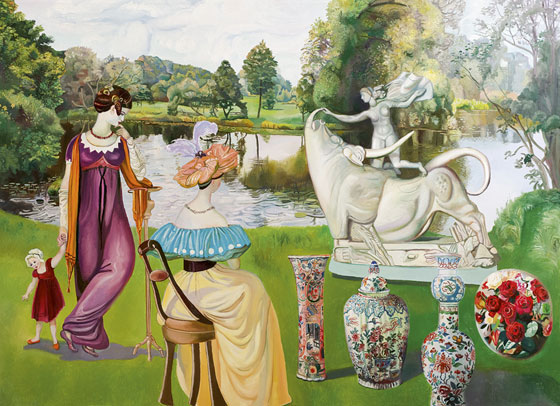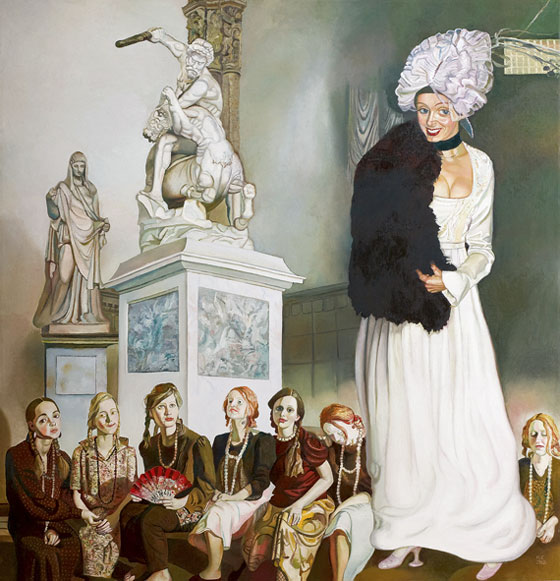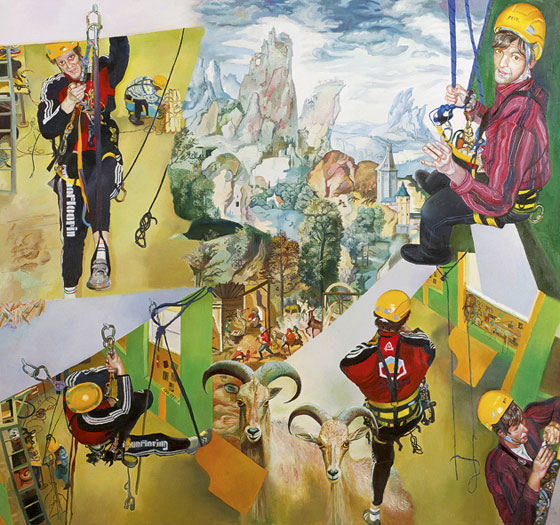|
|
| Tabaka. No comment Vilnis Vējš, Art Critic | |
| Maija Tabaka continues to allure and mystify: at exhibitions dedicated to Latvian post-war art viewers get “caught up” by her works: they stand there longer, investigating them in detail. That’s how it was in the Artist. Portrait. Self-Portrait exhibition at the National Museum of Art (December 2009–January 2010), and the same again at the Painting in Latvia 1950–1990 from the Artists’ Union of Latvia Collection show, which could be viewed from May to August at Riga Art Space. Even if Tabaka’s paintings have not been particularly highlighted (as in Portraits...), or have been placed in completely cramped circumstances in the context of the most brilliant achievements of Latvian painting (at Riga Art Space), their magnetism is not diminished. Quite the opposite – in the congestion of conventionally recognized artistic treasures, many other masterpieces lose some of their uniqueness and reveal their connection with a particular tradition, providing substance for comparisons, but Tabaka once again stands out. At the close of 2010 there was an exhibition at the Ivonna Veiherte Gallery showing Tabaka’s paintings from recent years, including a newly-painted version of the legendary work no longer accessible to Latvian viewers, The Jungle (first exhibited in 1977 in West Berlin). This look back into the past, instigated by the author herself, makes one conclude that she is the most striking artist of her time – this can be safely declared, even with-out adding the usual modifier “one of...” and just leaving the word “striking”, without clarification. Why so? We could seek the answer in Līga Blaua’s [new] book Maija Tabaka. Spēle ar dzīvi [‘Maija Tabaka. A Game with Life’] published by Jumava and probably destined to be a bestseller. This is a record of memories divulged, in which the strong point is the authenticity of the narrative – one can almost hear Tabaka’s honest, yet considered manner of speaking in the text, but the weak point is journalistic super-ficiality. It seems that the interviewer, in sorting through the voice recordings, has been completely carried away by the tide of the artist’s recollections, instead of questioning her again about significant events and finding out something for herself. There aren’t many dates in the book. The composition of the text is limited to the division into a hundred little stories, some of which aren’t even a page long. The range of illustrations is also rather meagre (responsible editor – Evija Veide). It completely lacks the footnotes, foreword or epilogue and commentary required for a serious publication. However, these are sorely needed, as a number of the artist’s phrases, expressed in her characteristic laconicism, still offer significant germinal ideas for possible interpretations of her art. | |
 Maija Tabaka. Mythology. Oil on canvas. 139x191 cm. 2008. Publicity photo | |
| Dzīves teātris [‘The Theatre of Life’], Tabakas kundzes teātris [‘Mrs Tabaka’s Theatre’] – these chapter titles emphasize Maija Tabaka’s oft-stated likening of her art to theatre which, like a cliché, is repeated rather often, but without real analysis. An episode is related in the book from the beginning of the 1960s, when the budding artist was walking along the street in a flowing coat, with a man’s cap on her head and a scarf made out of a curtain around her neck, inciting the amazement and scorn of passers-by. This is evidence of something more than just a feminine desire for adornment (even though this, too, could have its place in an analysis of the artist’s activities in a feminist discourse). The classic practitioner of the performance genre Andris Grīnbergs, for example, operated in a very similar way, and as such has been valued from a longer distance of time and owing to the interest of foreign curators. Similarly, although not to the same extremes as Grīnbergs, who transformed his life into works of art, dressing and undressing his own body and that of his wife Inta Grīnberga, Maija Tabaka is a chronicler of the disappearing manifestations of an era, both accurately capturing the look of her models as well as being, as now-adays would probably be called, a “stylist”. In the book we can read about a summer spent at Rundāle, when the “palace and those games were for us like a protest against the uniformity and drabness imposed on us in the sixties” (p. 75 – without specifying the year), which along with other colourful episodes mark Tabaka’s creative work not only with paintings, but also body-art and the coordinates of art happenings, the social and symbolic meaning of which are only gradually being studied and investigated. However, in contrast to Grīnbergs, whose creative programme was not permitted access to the public art sphere, Maija Tabaka chose, and had the opportunity, to put into effect another – the role of painter. This adherence to “art for art’s sake” induces the examination of Tabaka’s paintings in an academically detached way, however the strength of her personality emerges even when presenting the problem of the autonomy of aesthetic experience and confronting this with trivial visual signs. The book reveals the simultaneously spontaneous and very deliberate, programmatic nature of this approach. In A Game with Life there are countless episodes discussing the artist’s choice of clothes for various occasions. Initially these seem quaint, as if paying dues to the themes typical of women’s magazines (the book was brought out in collaboration with the publishing house Santa), but later provide more than just a single clue towards an understanding of the imagery of her art. The main one of these – the possibility of a wider perspective, in which painting is no longer traditionally separable from performative, situational aesthetic gesticulation. Maija Tabaka’s paintings are a good example of the simultaneous appropriation of various 20th century Western art movements into Soviet cultural space. Truly, Tabaka has had a major role in the legit-imization of the so-called “associative painting” concept in Latvian art (see Konstants Zigurds in the ‘Maija Tabaka’ album of reproductions, Riga, Liesma, 1983) and the opening up of freedom of expression that is associated with it. It may even be possible to accurately date the beginning of this movement with the 1969 work Ships from Ancient Times, in which the motifs of ancient engravings and illustrations are combined in a phantasmagorical compilation. | |
 Maija Tabaka. At the museum. Oil on canvas. 151x146 cm. 2009. Publicity photo | |
| It was not without good reason that this painting was restored in 2010 and included in the AND OTHERS – Movements, Explorations and Artists in Latvia, 1960–1984 exhibition. And not without discussion either, because the artist’s subsequent creative work can in no way be included in the officially “rejected” or “discriminated against” art trends. However, having chosen so-called figural painting as her sphere of activity – this being the most prestigious and particularly State-supported form of artistic practice in Soviet art – Tabaka introduces into it a whole host of formal and ideological innovations which at times bordered on subversive activity. Tabaka extensively uses the “associative” composition principle, in which the unity of time and space is dismantled and classically developed fragments are combined which, however, as opposed to collage, don’t always have clearly defined borders, creating peculiar “interruptions” in the message. In this kind of painting, along with studies of nature, references to dreams and visual images from romantic fantasy also become possible. Another peculiarity of Tabaka’s talent is one she herself formulated in an interview this summer, her special “stereoscopic vision”. The deliberate cultivation of this has allowed her to create optical illusions, object spatiality and spatial depth effects on the painting plane, which, when combined with the montage of images, provide real conundrums in the relationship between the foreground and background, between objects and their surroundings. The third characteristic trait, which sets apart Tabaka’s painting from the works of her contemporaries, is the portrayal of figures in movement, captured in the moment. In her memoirs she convincingly reveals the circumstances under which the “controversial idea: to do the opposite – to move to the moment, to the elusive” (p. 87) was born. This idea links Tabaka with the seemingly opposite direction to romantically realistic painting – photorealism, which in the 1970s experienced a sudden blossoming in the works of Imants Lancmanis, Līga Purmale and Miervaldis Polis. Unlike the artists mentioned, Maija Tabaka didn’t imitate the framing of a photograph, moreover, she’d initially modelled the poses and angles of the figures “in her head”. Still, the viewer can discern in Tabaka’s paintings a wonderful production, the footprints of staged processes independently of whether they have taken place in real life or in the artist’s imagination. It should be noted that, to the great regret of the researchers of future generations and maybe also collectors, the artist chose to destroy her source materials – sketches, drafts and photographs – after the completion of each painting. Such choices unexpectedly conceptualize the ephemerality of time and the ability of art to be its only true witness, as an important theme for the artist. | |
 Maija Tabaka. Time Travel. Oil on canvas. 140x150 cm. 2008. Publicity photo | |
| Along with formal innovations, the image gallery of Soviet era in-formal culture has also found expression in Tabaka’s painting. For example, in the famous Wedding at Rundāle painting, which the artist herself considers her own “creative birth”, not only is a vision immortalized on canvas, but the real interpretation of an artistic event. Historical costumes, pastiches, fashionable garments and accessories, and symbols of Western popular culture, ideologically as if “break open” the canons of figural painting and portrait genres, infecting the standardized parade “uniform” of the stagnation years with the viruses of a marginalized aesthetic. Maija Tabaka, classified as a portrait painter, has in fact created a succession of portrait-like masterpieces that can be conventionally interpreted, in which one can search for both psycho-logical as well as typical traits. However, Tabaka has consistently sought to dissolve the differentiation of art into “high” and “low” genres, recording in a detailed way the current fashion in make-up and hair-style, clothes and accessories. In this perspective her visit to West Berlin in 1977, often mentioned and also exhaustively described in her book of memoirs, could be considered as the mission of a double agent: obviously, this didn’t take place without the mandate of state institutions, entrusted with the mission of popularizing Soviet art and improving its image in the “capitalism camp”, however, what the ruling power received in return was – a pro-Western orientation among the artistic community, which the artist herself hastened to spread whilst working as exhibition curator in the Artists’ Union and especially in her contact with younger colleagues, as well as a vast quantity of information and inspiration which later played a historical role in the collapse of the regime. The lack of commentary in Tabaka’s memoirs is like an incentive for potential researchers to write some: even just because many of the directions originated by her in Latvian art have remained separate, without continuation and therefore the connections between cause and effect have not been analyzed. It is significant that, despite the adulation of viewers and also the formal honours which the artist has received, they have always come in a package together with a certain suspicion and incomprehension on the part of academic circles – perhaps due to the pronounced masculine and elitist disposition of this community? How would it be if Maija Tabaka herself had students and followers, as a personality of this magnitude would warrant? Using the analogies of the theatre – of course, that would be a completely different play. /Translator into English: Filips Birzulis/ | |
| go back | |







